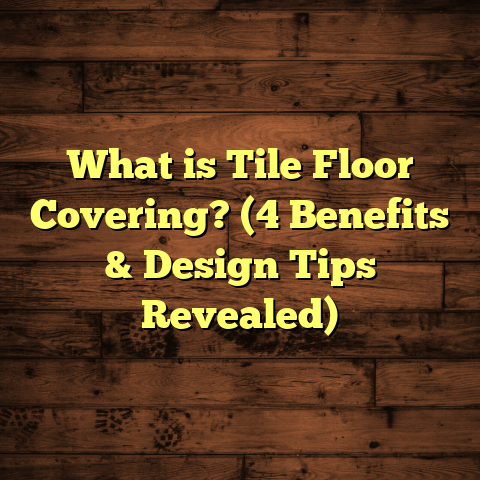What is Floor Trim Called? (5 Types You Must Know!)
When I first got into flooring work, one of the questions I heard over and over from homeowners and even some contractors was, “What’s that little strip called around the edges of the floor?” It’s funny how such a small piece can cause confusion. But those little strips—what we call floor trim—actually have a huge impact on how a room looks and feels once the flooring is done. If you’re wondering what floor trim is all about, or which types you should know before starting your next project, stick with me. I’ll walk you through everything I’ve learned over the years.
What Is Floor Trim?
Floor trim is a collective term for various finishing pieces that go around the edges of your floor. These pieces cover gaps between flooring and walls, protect both surfaces from damage, and give your floors a clean, finished look.
Think about it—when you install hardwood, laminate, tile, or any other flooring, there’s usually a small gap left between the edge of the floor and the wall. Why? Because floors need room to expand and contract naturally with temperature and humidity changes. Without some kind of trim, these gaps would be obvious and unsightly.
Floor trim comes in many shapes and sizes. The most common materials are wood (both solid hardwood and engineered), MDF (medium-density fiberboard), PVC (plastic), and metal. Each has its own manufacturing process, advantages, and ideal uses.
Materials and Manufacturing
Let me get a bit technical here since understanding materials helps when choosing trim.
- Solid Wood: Hardwood trims like oak, maple, or pine are kiln-dried to reduce moisture content to around 6-8%. This drying process minimizes warping or cracking after installation. Once dried, the wood is milled through molding machines that shape custom profiles—whether simple flat boards or elaborate colonial designs. Some trims are sanded smooth and left raw for onsite finishing; others come pre-stained or painted.
- MDF: MDF trims are made by compressing wood fibers with resin under high pressure. The result is a dense, smooth board without natural grain. These trims are usually primed or painted factory-finished since MDF doesn’t take stain well. They’re popular because they’re cost-effective and stable but can swell if exposed to moisture.
- PVC: Plastic trims are extruded from PVC resin. They’re waterproof and great for damp areas like basements or bathrooms but don’t have the warmth of wood.
- Metal: Less common for residential floors but sometimes used in commercial settings or for transition strips. Made through cutting and bending sheet metal or aluminum extrusion.
Each material’s manufacturing impacts durability, finish options, cost, and installation method.
Why Floor Trim Matters
You might ask: why fuss over something small? Well, I’ve seen many projects where floors looked stunning but felt unfinished because the right trim wasn’t installed—or worse, the wrong trim was used.
Besides aesthetics, trim covers expansion gaps that can be up to 3/8 inch wide or more depending on flooring type and climate. Without trim, these gaps expose subfloor edges that can collect dirt or damage easily.
Trim also protects walls from scuffs caused by furniture or vacuums. And it hides uneven cuts where flooring meets walls—usually unavoidable in remodeling older homes.
In short: floor trim adds polish, protects your investment, and can even influence your home’s resale value.
The 5 Types of Floor Trim You Should Know
Over my years installing floors in dozens of homes, five types of floor trim always come up. Knowing these will help you understand your options—and avoid mistakes.
1. Baseboard
Baseboards are the most familiar type of floor trim. They run horizontally along the bottom of walls where they meet the floor. Their job is twofold: cover expansion gaps between floor and wall, and protect walls from scuff marks.
Size & Styles: Baseboards vary widely in height—from 3 inches for simple rooms to 8 inches or more in grander spaces. Decorative profiles range from plain square edges to detailed colonial or Victorian styles with curves and ridges.
Materials: Solid hardwood baseboards are common for durability in living spaces and high-traffic rooms. MDF is popular too because it’s cheaper and easy to paint smoothly.
Manufacturing: Hardwood baseboards start as kiln-dried lumber cut into planks. These planks then pass through molding machines equipped with custom router bits to create specific profiles. After shaping, edges are sanded smooth for finishing.
Installation Tips: I always recommend nailing baseboards into wall studs for a secure hold using finishing nails. Caulking along edges hides nail holes and creates a seamless look.
My Experience: On one large renovation job, we installed 7-inch oak baseboards with a classic ogee profile in the main hallway. The homeowners were blown away by the “wow” factor it added compared to their previous plain trims. It showed me how something as simple as a taller baseboard can completely change a room’s character.
2. Quarter Round
Quarter round molding is shaped like a quarter of a circle in cross-section. It sits at the base of baseboards where they meet the floor.
Function: Its main role is to cover small gaps between floors and baseboards—especially useful if the floor isn’t perfectly level or has slight variations along edges.
Materials & Manufacturing: Usually made from pine or poplar wood that’s milled into rounded profiles using routers or molding machines. Sometimes pre-primed or painted before sale.
Installation: Nailed into the baseboard rather than the floor to allow floor movement underneath without cracking paint or wood.
Why I Use It: On laminate floor installs, I always add quarter round because laminate expands and contracts more than hardwood. The quarter round hides these gaps nicely without interfering with movement.
3. Shoe Molding
Shoe molding looks similar to quarter round but is slightly thinner and taller with a more subtle curve.
Use Case: It covers expansion gaps like quarter round but provides a sleeker finish. Good for rooms with thicker carpet padding or where you want less bulky trim.
Materials & Manufacturing: Like quarter round, usually wood or MDF shaped with routers. Painted shoe molding is popular since it blends with baseboards.
Personal Insight: I prefer shoe molding in bedrooms where softness matters—less bulky means less chance of catching socks or vacuum cleaners on it.
4. T-Molding
T-molding bridges two floors that meet at the same height but are different materials—like hardwood meeting tile or laminate meeting vinyl planks.
Design: Its shape looks like a “T” from above—the vertical stem fits into a track between floors while the horizontal top covers edges.
Manufacturing: Wood T-molding goes through similar drying and shaping processes as baseboards. Vinyl versions are extruded through molds for consistent shapes.
Installation: Often installed with an aluminum track anchored into subflooring for secure fit and easy replacement if needed.
Why It Matters: Without T-molding, floors could chip at junctions or leave awkward visible seams. It provides a smooth visual break between different surfaces.
Case Study: In one office renovation, we used wood T-molding to separate hardwood conference room floors from adjacent carpet tiles in hallways. The clean line visually defined spaces while preventing tripping hazards.
5. Reducer Strip
Reducer strips solve the problem when two floors meet but one is slightly higher than the other—say hardwood next to vinyl planks that sit lower.
Function: The strip slopes down gently from one floor height to another, creating a smooth transition that prevents trips or damage at edges.
Materials & Manufacturing: Made from wood, laminate, or vinyl shaped into precise sloped profiles on molding machines or extrusion lines.
Installation Tips: Fastened securely into subflooring and sometimes glued on top depending on surface type.
My Experience: Older homes often have uneven flooring thicknesses due to multiple renovations over decades. Adding reducers saved us from having to rip out whole floors just to match heights perfectly—a big cost saver for clients.
Why Floor Trim Is More Than Just Decoration
I’ve worked on many floors where clients initially thought trim was just an afterthought—something they could skip or pick randomly. But after installation, they realized how much difference it made.
Here’s why floor trim is essential beyond looks:
- Protects Walls & Floors: Trim absorbs knocks from furniture moving and vacuum cleaners instead of your walls.
- Covers Gaps & Imperfections: No flooring is perfectly cut—trim hides uneven cuts or gaps.
- Allows Expansion & Contraction: Wood floors can expand/contract up to 3/8 inch over 10 feet depending on humidity.
- Improves Acoustics: Trim helps seal gaps that might let sound travel under doors or between rooms.
- Adds Value: Real estate experts say good quality finishes including trim can boost perceived home value by up to 5%.
How I Manage Costs & Budgeting Using FloorTally
Cost estimating can be tricky when you’re juggling materials, labor rates, waste factors, and trim choices across rooms. That’s why I rely heavily on tools like FloorTally for my projects.
It lets me input local labor rates (which can differ hugely by region), choose specific materials (hardwood baseboards vs MDF shoe molding), add waste percentages for cuts and mistakes, then generate accurate cost breakdowns fast.
Here’s how it helps me:
- Accurate Quotes: No more guessing prices based on rough estimates.
- Material Comparisons: Easily see how switching from wood trim to MDF affects costs.
- Waste Management: Automatically factors in extra material needed so I don’t run short.
- Time Saver: Cuts down back-and-forth phone calls with suppliers and subcontractors.
- Budget Transparency: Clients appreciate when I show them detailed cost breakdowns upfront.
One project involved installing over 1,000 linear feet of flooring and trim across five rooms with mixed materials. Using FloorTally helped me avoid ordering too much trim (which would waste money) or too little (which would cause delays).
Technical Details About Installation & Finishing
Getting floor trim right isn’t just about picking the right style—it requires precise installation and finishing techniques:
- Moisture Control: Wood trims should be acclimated on-site for several days before installation to match room humidity.
- Cutting Angles: Miter saws set at 45 degrees create perfect corners for baseboards meeting in corners.
- Nail Types: Use finishing nails (15 or 16 gauge) driven at an angle with nail sets to avoid splitting.
- Caulking & Filling: Fill nail holes with wood filler; caulk gaps between wall and trim for smooth finishes.
- Painting & Staining: Pre-finish trims save time but onsite touch-ups may be necessary after installation.
- Expansion Gaps: Leave gaps around door frames and walls before covering with trim to allow movement.
- Floor Protection: During installation, protect finished flooring with drop cloths as nails and tools can scratch surfaces easily.
Personal Stories From Jobs That Taught Me About Trim
One time early in my career, I installed hardwood flooring without adding quarter round because I thought it was optional. A few months later, the client called complaining about visible gaps between floor and baseboards after humidity changed drastically during winter. That taught me never to skip those small trims—they serve important functions beyond looks.
In another project renovating an old farmhouse, we used thick pine baseboards with hand-carved profiles matching historic styles plus matching shoe molding stained dark walnut. The clients loved how authentic it felt even though everything was new construction underneath.
I also had a job installing engineered hardwood in a beach house where humidity swings were extreme. Using PVC shoe molding instead of wood saved us from future water damage since it didn’t swell like wood might near coastal humidity.
Industry Data & Trends in Floor Trim
Let me share some numbers from recent market research:
- The global market for moldings and trims is growing steadily at about 4% annually due to home renovations.
- Hardwood trims account for roughly 55% of residential installations; MDF holds about 35%, while PVC and metal make up smaller shares.
- Average baseboard heights have increased over past decades—from 3 inches in older homes to 5-7 inches in modern builds.
- Consumer preferences show growing interest in minimalist flat baseboards in contemporary homes versus ornate colonial profiles in traditional styles.
- About 60% of DIY homeowners install their own baseboards but rely on professionals for complex trim types like T-molding or reducers.
Choosing The Right Floor Trim For Your Project
Here are some quick tips based on what I’ve learned:
- For high-moisture areas like bathrooms or basements: use PVC trims.
- For historic restorations: solid hardwood with detailed profiles works best.
- For budget projects: MDF baseboards with paint finish provide good value.
- For modern minimalism: flat baseboards with shoe molding keep things clean.
- When transitioning between different floors: don’t forget T-molding or reducers—they prevent damage and tripping hazards.
- Always consider flooring movement—choose trims that allow expansion/contraction without cracking paint or splitting wood.
FAQs About Floor Trim
Q: Can I install floor trim myself?
A: Definitely! With basic tools like a miter saw, nail gun or hammer, caulk gun, and patience you can handle it well—just watch your measurements closely.
Q: How much should I budget for floor trim?
A: Baseboards typically run $1.50–$4 per linear foot depending on material; shoe molding around $0.75–$2 per foot; T-molding $3–$6 per foot; labor varies by region but often adds another 50–100% of material cost.
Q: Is it better to paint or stain my trims?
A: Both work well—paint hides imperfections but may chip; stain shows natural wood grain but needs sealed finish for durability.
Q: How do I maintain my floor trim?
A: Dust regularly; avoid soaking trims with water; touch up paint/stain as needed; repair dents quickly by filling/sanding/painting.
Final Thoughts
Floor trim might seem like a minor detail when planning floors—but after years working on projects big and small, I know it’s one of those finishing touches that can make all the difference in how your space looks and feels.
Whether you choose tall baseboards for drama or subtle shoe molding for softness, knowing your options helps you make smart decisions that protect your floors while adding style for years to come.
If you’re thinking about tackling this yourself—or want tips on hiring pros—just ask! I love sharing what I’ve learned about this often-overlooked part of flooring projects.
If you need help estimating costs or figuring out what trim fits your budget best, tools like FloorTally have been lifesavers for me—and they might help you too by giving clear numbers upfront so you’re not caught off guard later on.
Got questions? Fire away—I’m here to help!





